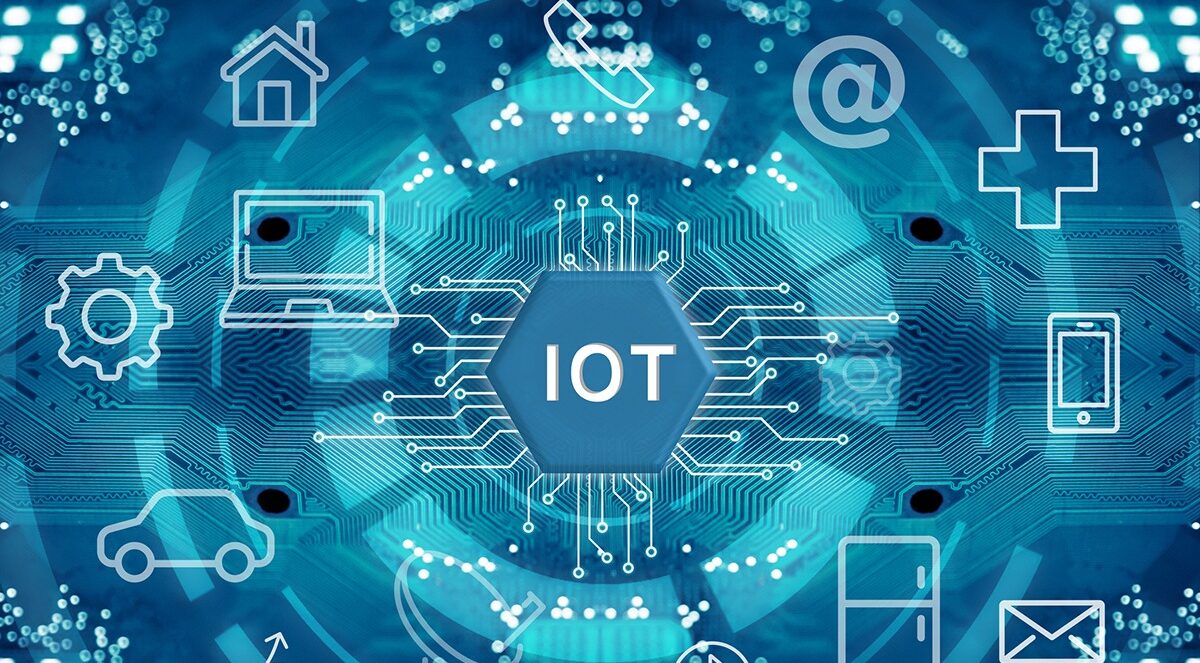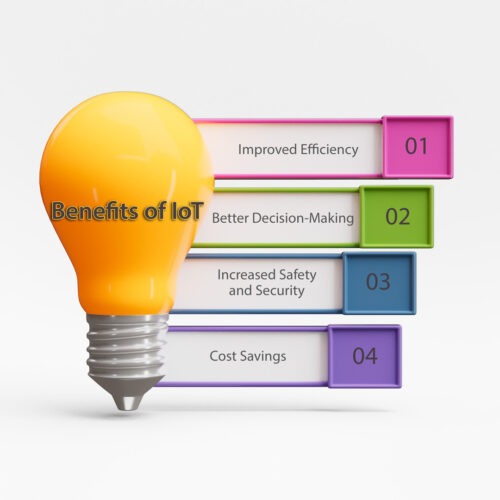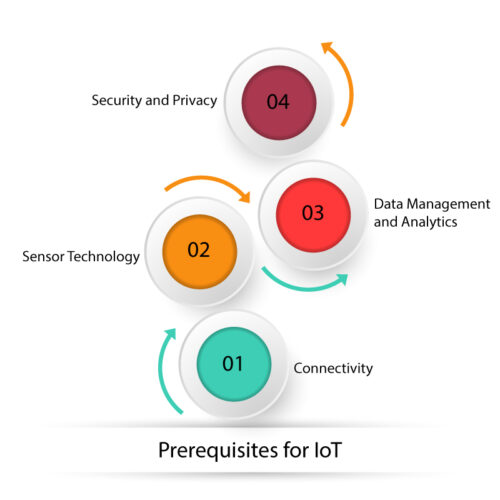
17 Jul Internet of Things IoT History, Benefits, and Prerequisites
Internet of Things has received a lot of attention in the past decade. IoT is physically linked objects connected to internet. These objects can be anything including machinery, automobiles, structures, and many other items, makes up the Internet of Things. These devices have firmware, internet connection, and sensor technologies.
A new era of connectivity where machines can communicate with both people and other machines has arrived thanks to the concept of the IoT. We are now applying Internet of Things technology for smart homes, smart cities, industrial machines, and wearable technologies.
IoT is increasingly having a big impact industries. Internet of Things is reshaping industries. Manufacturing, transportation, agriculture, and health care are like never before. IoT will therefore affect the future and make huge changes. We will discuss the development of IoT, its advantages, implementation, and the significance of resolving security in this blog.
History of IoT
The emergence of the first devices with internet connectivity in the early 1980s marked the beginning of the Internet of Things. Technological developments and the internet’s rising accessibility have propelled the IoT’s rapid expansion. In the late 1990s and 2000s, the phrase Internet of Things became a bit popular. IoT devices were fully used during this time as a result of developments in wireless communication, smaller sensors, and access to the web.
Wi-Fi and Bluetooth’s invention made it possible for devices to connect wirelessly (without any cable connections). IoT’s first stages mostly were RFID Radio Frequency Identification technology. RFID made it possible to monitor and identify anything via radio waves. RFID tags were fixed to items, and they could be scanned to get data and find out where they were.
The development of wireless communication technology marked the genuine IoT breakthrough. The development of Wi-Fi and Bluetooth made it possible for devices to connect wirelessly, doing away with the necessity for actual cable connections. The ability to share data and incorporate physical items into the digital realm was made simpler by wireless networking.
IoT development was greatly aided by the simultaneous shrinking of sensors and the dropping price of hardware components. Sensors are now possible to incorporate in a variety of goods due to advancements in sensor dimensions, cost, and power efficiency. Temperature, humidity, light, motion, and other environmental elements may all be detected and measured by these sensors.
IoT grew in popularity as the internet got more usable and dependable. The increasing usage of internet and smartphones helped IoT to grow faster. People began to carry internet-connected devices with them at all times. This made it easy to connect many products to the internet and enable remote control and monitoring.
Cloud computing has recently developed into a key IoT development. IoT devices can offload data, run analytics, and leverage strong computing resources thanks to cloud platforms’ scalable storage and processing capabilities. Real-time analytics, data processing, and IoT infrastructures are now possible. By merging technologies like AI, ML, and edge computing, IoT has reached a new stage in its evolution.
IoT devices can analyze massive volumes of data and get insightful knowledge thanks to intelligent algorithms and predictive analytics. The ability to collect and analyze data from our devices presents opportunities for further innovation and efficiency in our quality of life.
We shall examine the vast array of advantages that IoT delivers to many areas in the next section. From increased efficiency to enhanced decision-making, IoT’s impact is truly transformative.
Benefits of IoT
IoT offers a multitude of benefits in various sectors. Let’s explore some advantages that IoT brings to the table:
1. Improved Efficiency
- Real-time monitoring and automation are made possible by IoT, which improves productivity and operational effectiveness. Here are a few ways that IoT boosts effectiveness:
- Real-time Data Collection: IoT devices equipped with sensors gather data in real-time, providing valuable insights into various processes. For example, in manufacturing, sensors can monitor production lines, detecting anomalies and ensuring optimal performance.
- Optimized Processes: By analyzing data collected from IoT devices, organizations can identify inefficiencies, streamline operations, and optimize resource utilization. Costs are saved, production is increased, and downtime is decreased as a result.
2. Better Decision-Making
IoT devices’ data provides valuable insights for decision-making. Decision-making is aided by IoT in a few ways:
- Data-Driven Decision-Making: IoT generates massive amounts of data, allowing businesses to make informed decisions based on real-time information. Retailers can use consumer activity to assess customer experiences and customize their marketing campaigns accordingly.
- Predictive Analytics and Trend Identification: IoT data combined with advanced analytics techniques such as machine learning enables predictive capabilities. Organizations can identify trends, patterns, and anomalies, allowing them to anticipate future outcomes, mitigate risks, and capitalize on opportunities.
3. Increased Safety and Security
IoT has the ability to improve security and safety in a variety of contexts. Below are a few instances of how IoT improves security and safety:
- Public Safety: In smart cities, IoT plays a crucial role in improving public safety. IoT surveillance systems, sensors, and devices enable efficient monitoring of public spaces, rapid response to emergencies, and effective traffic management.
- Industrial Safety: In industrial settings, IoT-enabled sensors can detect hazardous conditions, monitor equipment health, and ensure worker safety. For example, sensors can detect changes in temperature, pressure, or gas levels, triggering alarms or automated shutdowns to prevent accidents.
4. Cost Savings
IoT applications lead to significant cost savings by optimizing resource utilization and streamlining operations. Like the following:
- Smart Energy Management: IoT-based smart grids enable efficient energy distribution, reduce energy waste, and empower consumers to monitor and manage their energy consumption. This helps save cost for both energy providers and us.
- Smart Agriculture: IoT sensors in agriculture can monitor soil moisture levels, weather conditions, and crop health, allowing farmers to optimize irrigation, minimize water usage, and precisely apply fertilizers. This reduces costs while maximizing crop yield and quality.
The benefits of Internet of Things IoT are not just limited to these examples. IoT is evolving with technology advancements. Let’s now explore the prerequisites for successful implementation of IoT.

Prerequisites for IoT
To ensure successful implementation of IoT, several prerequisites need to be in place. Let’s explore the key factors that lay the foundation for integrating IoT into various environments:
1. Connectivity
Reliable and high-speed internet connectivity is essential for the seamless operation of IoT devices. Different connectivity options can be utilized based on the specific requirements of the IoT application:
- Wi-Fi: Wi-Fi provides devices within a specific range with high-speed wireless communication. Everywhere—in residences, workplaces, and public areas—it is accessible.
- Cellular Networks: Cellular networks provide broader coverage and allow IoT devices to be connected in remote locations. They are ideal for applications that require mobility or connectivity in areas without Wi-Fi coverage.
- Low-Power Wide-Area Networks (LPWANs): LPWANs, such as Lora WAN and NB-IoT, are designed for long-range communication with low power consumption. They are suitable for IoT applications that require low data rates and long battery life, such as smart agriculture or asset tracking.
2. Sensor Technology
IoT collects data of physical environment from sensors. These IoT sensors come in different shapes. Some commonly used sensors in IoT applications include:
- Temperature Sensors: Measure temperature variations and are used in applications such as environmental monitoring and HVAC systems.
- Humidity Sensors: Monitor humidity levels in environments such as greenhouses, warehouses, and museums.
- Accelerometers: Detect motion, vibration, and orientation, making them valuable in applications like asset tracking, wearable devices, and industrial machinery monitoring.
3. Data Management and Analytics
Handling and processing the vast amounts of data generated by IoT devices require robust data management and analytics capabilities. Key components of data management and analytics in IoT include:
- Cloud Computing: Cloud platforms provide scalable storage and computational resources, allowing IoT devices to store and offload data. Cloud based solutions also help us with data processing, analytics, and integrate IoT with our existing systems.
- Big Data Analytics: Analyzing IoT-generated data requires advanced analytics techniques such as machine learning and artificial intelligence. These technologies help uncover patterns, derive insights, and enable predictive capabilities for making informed decisions.
4. Security and Privacy
With the increased connectivity and data exchange in IoT, security and privacy concerns become critical. Ensuring the safety and integrity of IoT devices and the data they generate is crucial. Some essential considerations include:
- Encryption: Strong encryption protocols should be implemented to protect data transmission and storage.
- Authentication and Access Control: IoT devices should have secure authentication mechanisms to prevent unauthorized access.
- Security Updates and Patch Management: Regular security updates and patch management for IoT devices and systems are necessary to address vulnerabilities and protect against evolving threats.
We will be able to successfully use IoT’s technology into our business if we follow these guidelines.

Conclusion
Internet of Things has changed our ways of working. We open new doors by combining IoT with big data analytics, cloud computing, AI, and machine learning. To guarantee that IoT technology is widely used and accepted, it is crucial to solve security and privacy concerns first. We can successfully apply IoT technology into our firm by fulfilling these prerequisites. In conclusion, it is apparent that the Internet of Things is transforming several fields and everyday life. IoT will have a greater effect and open up new opportunities when cloud computing, big data analytics, artificial intelligence, and machine learning are combined. For IoT technologies to be widely used and accepted, security and privacy issues must be resolved.